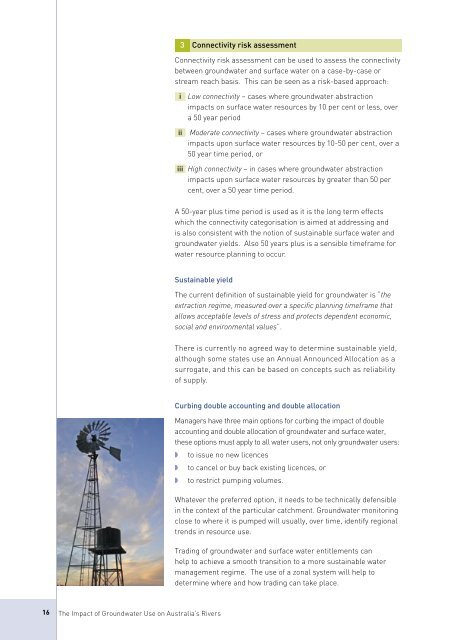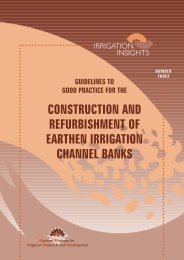The Impact of Groundwater Use of Australias Rivers
The Impact of Groundwater Use of Australias Rivers
The Impact of Groundwater Use of Australias Rivers
Create successful ePaper yourself
Turn your PDF publications into a flip-book with our unique Google optimized e-Paper software.
3 Connectivity risk assessment<br />
Connectivity risk assessment can be used to assess the connectivity<br />
between groundwater and surface water on a case-by-case or<br />
stream reach basis. This can be seen as a risk-based approach:<br />
i Low connectivity – cases where groundwater abstraction<br />
impacts on surface water resources by 10 per cent or less, over<br />
a 50 year period<br />
ii Moderate connectivity – cases where groundwater abstraction<br />
impacts upon surface water resources by 10-50 per cent, over a<br />
50 year time period, or<br />
iii High connectivity – in cases where groundwater abstraction<br />
impacts upon surface water resources by greater than 50 per<br />
cent, over a 50 year time period.<br />
A 50-year plus time period is used as it is the long term effects<br />
which the connectivity categorisation is aimed at addressing and<br />
is also consistent with the notion <strong>of</strong> sustainable surface water and<br />
groundwater yields. Also 50 years plus is a sensible timeframe for<br />
water resource planning to occur.<br />
Sustainable yield<br />
<strong>The</strong> current definition <strong>of</strong> sustainable yield for groundwater is “the<br />
extraction regime, measured over a specific planning timeframe that<br />
allows acceptable levels <strong>of</strong> stress and protects dependent economic,<br />
social and environmental values”.<br />
<strong>The</strong>re is currently no agreed way to determine sustainable yield,<br />
although some states use an Annual Announced Allocation as a<br />
surrogate, and this can be based on concepts such as reliability<br />
<strong>of</strong> supply.<br />
Curbing double accounting and double allocation<br />
Managers have three main options for curbing the impact <strong>of</strong> double<br />
accounting and double allocation <strong>of</strong> groundwater and surface water,<br />
these options must apply to all water users, not only groundwater users:<br />
◗<br />
◗<br />
◗<br />
to issue no new licences<br />
to cancel or buy back existing licences, or<br />
to restrict pumping volumes.<br />
Whatever the preferred option, it needs to be technically defensible<br />
in the context <strong>of</strong> the particular catchment. <strong>Groundwater</strong> monitoring<br />
close to where it is pumped will usually, over time, identify regional<br />
trends in resource use.<br />
Trading <strong>of</strong> groundwater and surface water entitlements can<br />
help to achieve a smooth transition to a more sustainable water<br />
management regime. <strong>The</strong> use <strong>of</strong> a zonal system will help to<br />
determine where and how trading can take place.<br />
16<br />
<strong>The</strong> <strong>Impact</strong> <strong>of</strong> <strong>Groundwater</strong> <strong>Use</strong> on Australia’s <strong>Rivers</strong>

















